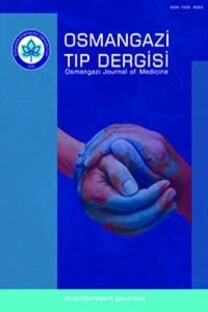Fonksiyonel Amaçla Üst Kapak Blefaroplasti Yapılan Hastaların Sonuçları ve Hasta Memnuniyetlerinin Değerlendirilmesi
Blefaroplasti, Glaskow Benefit Inventory, yaşam kalitesi
Evaluation of Results and Patient Satisfaction of Patients who Underwent Upper Lid Blepharoplasty for Functional Purposes
___
- Nagi KS, Carlson JA, Wladis EJ. Histologic Assessment of Dermatochalasis: Elastolysis and Lymphostasis are Fundamental and Interrelated Findings. Ophthalmology. 2011;118(6):1205-10.
- Shirado M. Dyslipidaemia and Age-related Involutional Blepharoptosis. J Plast Reconstr Aesthet Surg. 2012;65(6):e146-50.
- An SH, Jin SW, Kwon YH, and et al. Effects of Upper Lid Blepharoplasty on Visual Quality in Patients with Lash Ptosis and Dermatochalasis. Int J Ophthalmol. 2016;9(9):1320-4.
- Battu VK, Meyer DR, Wobig JL. Improvement in Subjective Visual Function and Quality of Life Outcome Measures after Blepharoptosis Surgery. Am J Ophthalmol. 1996;121(6):677-86.
- Herruer JM, Prins JB, van Heerbeek N, and et al. Patient-reported Outcome Measurement in Upper Blepharoplasty: How to Measure What the Patient Sees. J Plast Reconstr Aesthet Surg. 2018;71(9):1346-51.
- Klingenstein A, Hintschich C. Update on Upper Eyelid Blepharoplasty. Ophthalmologe. 2018;115(4):266-74.
- Carroll RP, Mahanti RL. En Bloc Resection in Upper Eyelid Blepharoplasty. Ophthalmic Plast Reconstr Surg. 1992;8(1):47-9.
- Brennan HG, Joseph BA. Delineating the Cleft in Upper Blepharoplasty. Arch Otolaryngol. 1979;105(9):515-8.
- Robinson K, Gatehouse S, Browning GG. Measuring Patient Benefit from Otorhinolaryngological Surgery and Therapy. Ann Otol Rhinol Laryngol. 1996;105(6):415-22.
- Uysal Y, Cakmaklioğullari M. Evaluation of the Quality of Life of Patients with External Dacryocystorhinostomy and Punktoplasty Operation. Turkiye Klinikleri Journal of Ophthalmology. 2019;28(4):239–49.
- Naik MN, Honavar SG, Das S, and et al. Blepharoplasty: An Overview. J Cutan Aesthet Surg. 2009;2(1):6-11.
- Lieberman DM, Quatela VC. Upper Lid Blepharoplasty: A Current Perspective. Clin Plast Surg. 2013;40(1):157-65.
- Hoorntje LE, Lei B, Stollenwerck GA, and et al. Resecting Orbicularis Oculi Muscle in Upper Eyelid Blepharoplasty--A Review of the Literature. J Plast Reconstr Aesthet Surg. 2010;63(5):787-92.
- Rohrich RJ, Coberly DM, Fagien S, and et al. Current Concepts in Aesthetic Upper Blepharoplasty. Plast Reconstr Surg. 2004;113(3):32e-42e.
- Gradinger GP. Cosmetic Upper Blepharoplasty. Clin Plast Surg. 1988;15(2):289-97.
- Saadat D, Dresner SC. Safety of Blepharoplasty in Patients with Preoperative Dry Eyes. Arch Facial Plast Surg. 2004;6(2):101-4.
- Gulyás G. Improving the Lateral Fullness of the Upper Eyelid. Aesthetic Plast Surg. 2006;30(6):641-50.
- van der Lei B, Timmerman IS, Cromheecke M, and et al. Bipolar Coagulation-assisted Orbital (BICO) Septoblepharoplasty: A Retrospective Analysis of a New Fat-saving Upper-eyelid Blepharoplasty Technique. Ann Plast Surg. 2007;59(3):263-7.
- Castañares S. Classification of Baggy Eyelids Deformity. Plast Reconstr Surg. 1977;59(5):629-33.
- Owsley JQ, Jr. Resection of the Prominent Lateral Fat Pad During Upper Lid Blepharoplasty. Plast Reconstr Surg. 1980;65(1):4-9.
- Raschke GF, Bader RD, Rieger UM, and et al. Photo-assisted Analysis of Blepharoplasty Results. Ann Plast Surg. 2011;66(4):328-33.
- Joshi AS, Janjanin S, Tanna N, and et al. Does Suture Material and Technique Really Matter? Lessons Learned from 800 Consecutive Blepharoplasties. Laryngoscope. 2007;117(6):981-4.
- Mahroo OA, Hysi PG, Dey S, and et al. Outcomes of Ptosis Surgery Assessed Using a Patient-reported Outcome Measure: An Exploration of Time Effects. Br J Ophthalmol. 2014;98(3):387-90.
- Maycock N, MacGregor C, Saunders DA, and et al. Long Term Patient-reported Benefit from Ptosis Surgery. Eye (Lond). 2015;29(7):872-4.
- Smith HB, Jyothi SB, Mahroo OA, and et al. Patient-reported Benefit from Oculoplastic Surgery. Eye (Lond). 2012;26(11):1418-23.
- Kamao T, Takahashi N, Zheng X, and et al. Changes of Visual Symptoms and Functions in Patients with and without Dry Eye after Lacrimal Passage Obstruction Treatment. Curr Eye Res. 2020;45(12):1590-7.
- Heemraz BS, Lee CN, Hysi PG, and et al. Changes in Quality of Life Shortly after Routine Cataract Surgery. Can J Ophthalmol. 2016;51(4):282-7.
- Taherian K, Atkinson PL, Shekarchian M, and et al. Comparative Study of the Subjective and Objective Grading of Ptosis Surgery Outcomes. Eye (Lond). 2007;21(5):639-42.
- ISSN: 1305-4953
- Yayın Aralığı: 6
- Başlangıç: 2013
- Yayıncı: Eskişehir Osmangazi Üniversitesi Rektörlüğü
Sosyal Medya Kullanımının Kadınların Estetik Cerrahiye İlişkin Tutumlarına Etkisi
Aliye OKGÜN ALCAN, Serpil ÇETİN
Bilal AYGUN, Didar YANARDAĞ AÇIK
Kemik Mineral Dansitesi ile Biyokimyasal Parametreler Arasındaki İlişki
Kilolu Çocuklarda Metabolik Sendrom Sıklığı ve Özelliklerinin Araştırılması
Akan YAMAN, İbrahim KANDEMİR, Fügen PEKÜN
Morel-Lavallee Lezyonunun Adli Travmatolojik Değerlendirilmesi: Bir Olgu Sunumu
Arif GARBİOĞLU, Tuğrul KILIBOZ, Beycan DOĞAN, Kenan KARBEYAZ
Multipl Skleroz Olarak Yanlış Teşhis Edilen Antifosfolipid Sendromu: Bir Olgu Sunumu.
Gülnur TEKGÖL UZUNER, Atilla Özcan ÖZDEMİR, Cengiz KORKMAZ, Nevzat UZUNER
Yatan Hasta Çocuk Nörolojisi Konsültasyon Sonuçları
Arzu EKİCİ, Cengiz HAVALI, Emre BALDAN, Muharrem BOSTANCI, Nevin KILIÇ
Elvan ÖZCAN GÜLŞEN, Çağrı GÜLŞEN, Fatih SOKE, Melahat SAYAN, Öznur TUNCA
COVİD-19 Aşıları Romatizmal Hastalığı Tetikleyebilir veya Alevlendirebilir; 4 Vakalık Derleme
Reşit YILDIRIM, Döndü ÜSKÜDAR CANSU, Mustafa DİNLER, Cengiz KORKMAZ
Ebeveyn Anksiyetesi ve Çocuklarda Baş Ağrısı ile İlişkisi
Çağla ÖZDEMİR, Cüneyt KARAGÖL, İbrahim ÖNCEL, Zeynep Selen KARALÖK, Ali GÜNGÖR, Gülser ŞENSES DİNÇ, Cenk AYPAK
